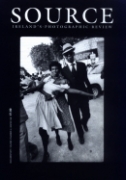Ray's a Laugh
Richard Billingham was at the Anthony Reynolds Gallery, London, 1996
Review by Anthony Haughey
Issue 10 Winter 1997
View Contents ▸
I first encountered Richard Billingham's work, Triptych of Ray, in the exhibition, Who's Looking at the Family? at the Barbican Gallery, London, 1994. Triptych of Ray was a series of grainy black and white melancholic portraits of his alcoholic father Ray, clutching a bottle in the half light of gloom and despair. Reminiscent of an earlier epoch, the photographs were taken as 'preliminary sketches' for painting studies, (Billingham was an art student at Sunderland University).
His investigation of the family has continued and results in his recent exhibition and book, 'Ray's a laugh', an intimate glimpse into the lives of his close family, living in a flat in Birmingham. A short description on the back cover of the book invites the viewer into their lives. Courtesy of Anthony Reynolds Gallery, London
Courtesy of Anthony Reynolds Gallery, London
His unemployed father Ray is a chronic alcoholic, his mother Elizabeth hardly drinks but smokes a lot and likes pets and "things that are decorative"; his brother Jason was taken into care when eleven, but is now back with Ray and Liz again. The text invites intimacy, encouraging the viewer to relate to the family by their first names, disguising the real distance between them and us.
'Ray's a laugh' is a new direction from Billingham's earlier intention of using the photograph as source material for paintings. It relates more specifically to established photographic genres, both documentary and casual snapshot. (The colour photos were developed and printed at the local chemist, occasionally arriving back with quality control stickers on them).
Documentary photography has tended to define poverty, hardship and social problems in terms of 'pioneering reform' or representing people as powerless victims. Such images are not designed for those they represent - do they produce knowledge to affect change? Are they simply designed to touch middle class consciences?
Snapshot photography is what most of us do on holiday, at birthday parties and other family events, 'frozen happy moments' immortalised in the family photo album, 'proof' of a secure domestic environment and the well being of the family. The family photo album is constructed for us by somebody else. Usually its the parents' memory that family photos represent, edited and presented as a memory of their offspring's childhood - photos of crying children, angry parents or divorced spouses conveniently erased from memory.
Diane Arbus, a New York photographer working during the 1960's held a special fascination for the family and concluded, "I think all families are creepy in a way". Since Arbus, photographers have continued to question 'traditional family values', encouraged by shifting perceptions of what constitutes the 'primary family unit'.
Although Richard Billingham's photographs are related to documentary and snapshot photography formally and contextually, they are also to an extent autobiographical. His extraordinary pictures break the code of silence surrounding the most private secrets of the family. His father is revealed as a pervasive, disruptive influence on family life.
The opening photograph in the book shows Ray seated on one side of a small cramped impoverished room, Liz standing opposite, shopping bag over her arm and fag in hand, trying to capture her husbands attention. Ray however is preoccupied as he stares blankly towards an empty homebrew container and two putrid beer stained glasses sitting on the table. Courtesy of Anthony Reynolds Gallery, London
Courtesy of Anthony Reynolds Gallery, London
The following photographs establish Ray's relationship with Jason, Liz and a menagerie of mangy animals. The latter appear to have a particular disdain for Ray's behaviour. In one picture, Ray is suddenly disturbed from a drunken stupor by one of the family cats, resulting in a surreal image of the cat temporarily airborne.
Jason, Billingham's younger brother often disappears at the edge of the frame, a powerless spectator, or in another photograph, escaping into a narcotic dream.
Liz appears to be more than a match for Ray's alcohol-induced behaviour, her heavily tattooed arms ready to thump her husband. Violence is evident in several images. In one we see the aftermath of a bloody encounter between the two, Liz handing Ray a blood stained tissue, fist clenched in fear of further onslaught.
Ray is finally stripped of all dignity in a picture where he lies sprawled around the smashed puke-stained toilet bowl.
Billingham's photographs have a formal awareness, which belies the casual snapshot feel, using symbol and metaphor to construct meaning from what anthropologists call material culture - what people own, how they dress, the objects they hang on their walls or pile up on tables, no frills packaging, tawdry furnishing and ornamental kitsch. Occasionally the formal construction is self conscious: Ray sitting on the edge of the bed, head downcast, the ubiquitous bottle beneath him and, just out of reach, a door key and some unwrapped slices of bread: this is his life sentence.
There is love, pain and violence in Richard Billingham's photographs, yet for all the apparent immediacy of his work, there is an undeniable distance between the family and viewer; the aesthetic and formal content, and strong use of colour in Billingham's domestic interiors fascinate and inform our reading of these images, although ultimately lessen our perception of the trauma of living with alcoholism.
Other articles mentioning Anthony Haughey:
Other articles mentioning Diane Arbus:






